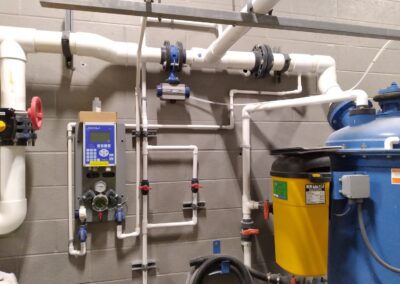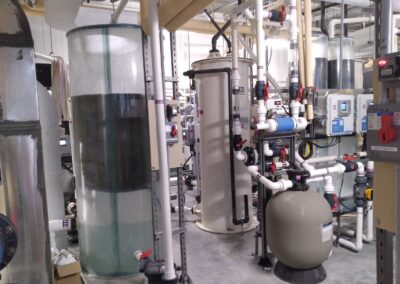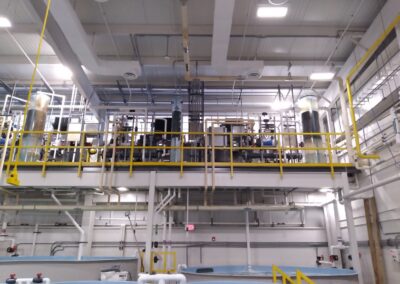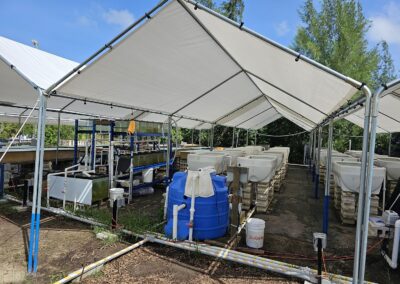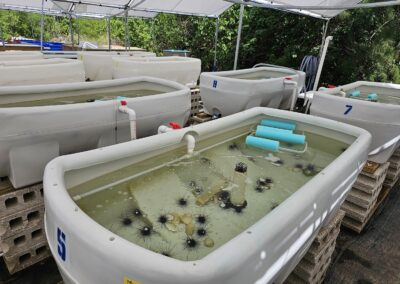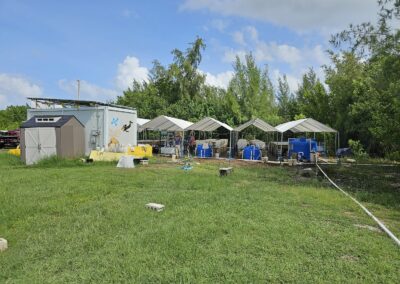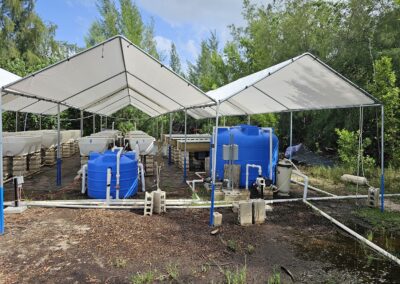5500 Gallon Freshwater Aquarium
|
Project |
5500 Gallon Freshwater Aquarium |
|
Client |
Virginia Wesleyan College |
|
Overview |
The purpose of the aquarium system is to provide an aesthetically pleasing display of Virginia’s indigenous fresh water fishes. Many combined components make up the aquarium system and each provide for a specific function in providing an attractive display. The major components are the aquarium structure, the filtration system and the lighting system. |
|
Aquarium Structure |
Aquatic Innovations worked with Stanmar architects to design a display with predetermined space and budget requirements. The aquarium structure is 28’ x 3’6″ x 8’ and contains an acrylic viewing panel. Built into the structure of the aquarium is a surface skimmer compartment. This surface skimmer is located at one end of the aquarium and has a weir to accept surface water from the display tank. The aquarium also has three drain fittings at the bottom centerline of the tank. Within the aquarium is a custom fabricated “insert”. This is a replica of a submerged Virginia river bank. |
|
Lighting System |
The lighting system consists of a series of specialty lights and timing devices that will illuminate the display for the viewers. Equally important is that the lights provide for an artificial source of radiation that approximates natural sunlight, both in spectrum and duration. |
|
Life Support System |
The mechanical systems will provide for a clean and healthy environment for the inhabitants of the tank. The mechanical systems consist of all equipment and piping for adding water to the system, filtering water within the system and removing water from the system. |
|
The water added to the system (make up water) will be pre treated by water conditioning filters and associated components. The purpose of this equipment is to remove constituents of municipally treated water that might be detrimental to the health of the fish. |
|
|
The filtration system or life support system (LSS) will provide for the filtration and circulation of water within the aquarium system. The LSS is the most extensive of the systems. It consists of all equipment associated with filtering the water and its removal from the system. The LSS will provide for the removal of particulate and dissolved organic compounds as well as biological and chemical treatment of the water. |
|
|
The objective of the LSS is to provide the aquarium with water that is healthy for the inhabitants and aesthetically pleasing for the viewer. Water is drawn from the tanks by pumps and then moved across or through filtering devices. The water is then returned to the tank at specific locations to provide current within the display tank. |
|
|
Water can be drawn from the tank via the surface skimmer or through a custom built gravel filter. The gravel filter consists of a support plate mounted seven inches above the bottom of the tank and covered with an ample layer of river gravel. The gravel bed will provide for extensive surface area necessary for growth of beneficial nitrogen consuming bacteria. The ratio of water moving through across the overflow and through the gravel bed can be varied to optimize the system. |
|
|
The filtration system is then comprised of two parallel loops. Each loop can be operated independent of the other and provides for redundancy in the event of a component failure. |
|
|
The first loop is the sand filtration loop. This sub-system consists of one pump and two sand filters. The primary objective is to provide for mechanical filtration, minor biological filtration and a method of eliminating accumulated waste products. The elimination of the waste products is accomplished by back flushing the sand filters to the sanitary drain system. Back flushing also serves to remove water from the system that can be replenished by freshwater. |
|
|
The second sub-system includes a pump, two canister filters and an ultraviolet sterilizer. Water is moved through the canister filters that provide for fine mechanical filtration as well as having the capability to hold chemical filtration media. The water will then pass through an ultraviolet sterilizer that will neutralize potentially harmful microorganisms. |

